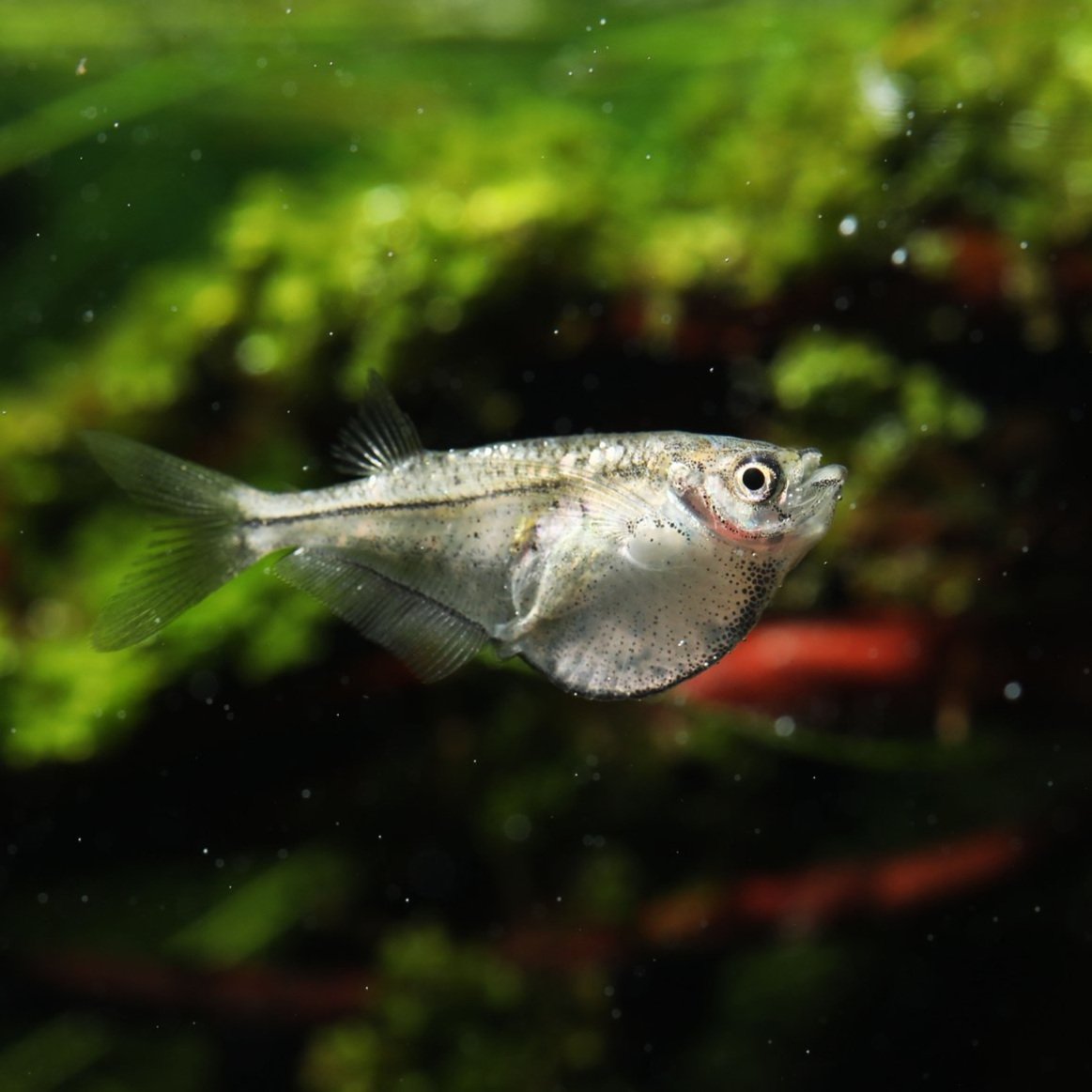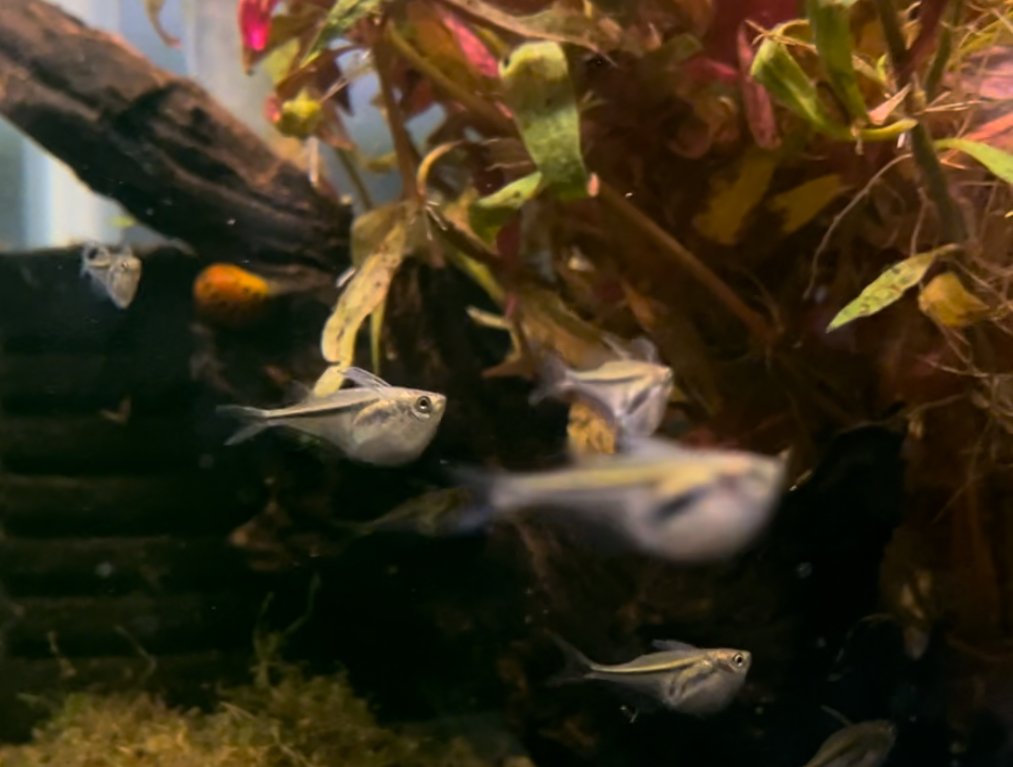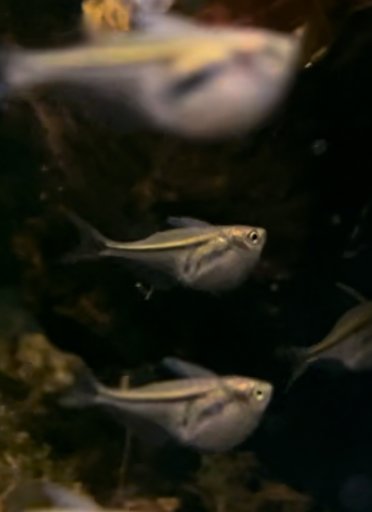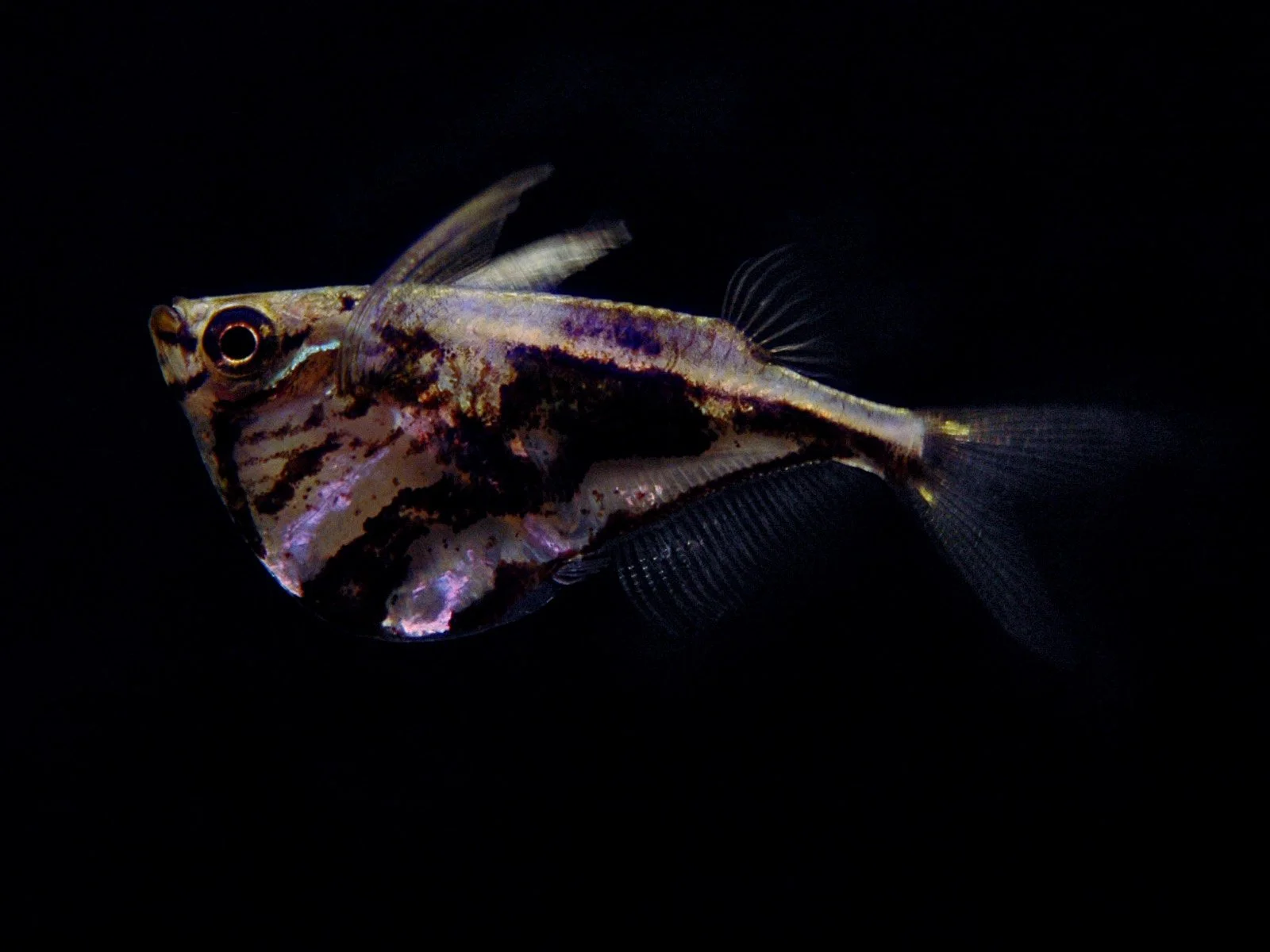 Image 1 of 2
Image 1 of 2

 Image 2 of 2
Image 2 of 2



Red Tail Hemiodus
The Red Tail Hemiodus, scientifically known as Hemiodus gracilis, is a striking and active freshwater fish native to the slow-moving rivers and floodplains of South America, particularly in the Amazon Basin. Known for its sleek body shape, vibrant red tail, and schooling behavior, this species is an excellent addition to larger aquariums designed to replicate riverine habitats. Its dynamic swimming and peaceful nature make it a captivating centerpiece in community setups.
Physically, the Red Tail Hemiodus has an elongated, torpedo-shaped body with a silvery base color. The standout feature is its bright red caudal fin, which provides a stunning contrast to its otherwise simple coloration. Some individuals may exhibit faint vertical stripes or a subtle iridescence along their bodies. Adult Red Tail Hemiodus typically grow to about 5 to 6 inches (12 to 15 centimeters) in length, requiring ample space to thrive.
In the aquarium, Red Tail Hemiodus are active swimmers and should be kept in groups of at least six to mimic their natural schooling behavior. A tank of at least 75 gallons is recommended, with plenty of open swimming areas and a soft, sandy substrate. Adding driftwood, rocks, and hardy plants like Vallisneria or Amazon swords can help create a natural environment while providing cover and reducing stress. These fish are excellent jumpers, so a tight-fitting lid is essential.
Water parameters for Red Tail Hemiodus should mimic their natural habitat. They prefer slightly acidic to neutral water with a pH range of 6.0 to 7.5 and temperatures between 75 to 82°F (24 to 28°C). Clean, well-oxygenated water is crucial, as these fish are sensitive to poor water quality. Regular water changes and efficient filtration are necessary to maintain a healthy environment.
Feeding Red Tail Hemiodus is straightforward, as they are omnivorous and have a hearty appetite. They readily accept high-quality flakes or pellets, as well as live or frozen foods such as brine shrimp, bloodworms, and daphnia. They may also nibble on algae or soft plant matter, so offering vegetable-based foods like blanched spinach or spirulina-based wafers can help round out their diet.
Red Tail Hemiodus are peaceful fish and do well in community tanks with other non-aggressive species of similar size. Suitable tank mates include larger tetras, peaceful cichlids, rainbowfish, and bottom-dwellers like Corydoras or plecos. Avoid housing them with very small fish, as they may be perceived as prey, or with highly aggressive species that could intimidate them.
Breeding Red Tail Hemiodus in captivity is uncommon and not well-documented, as they have complex reproductive behaviors in the wild. They are egg scatterers, and successful breeding would require a large, well-maintained tank with optimal water conditions and plenty of fine-leaved plants or spawning mops. Juveniles, if successfully raised, would need small foods like infusoria or finely crushed fry food.
Overall, the Red Tail Hemiodus (Hemiodus gracilis) is a sleek, active, and visually striking fish that adds movement and color to larger freshwater aquariums. With proper care, a spacious environment, and a varied diet, these fish can thrive and become a highlight of any community setup, providing a dynamic and lively display.
The Red Tail Hemiodus, scientifically known as Hemiodus gracilis, is a striking and active freshwater fish native to the slow-moving rivers and floodplains of South America, particularly in the Amazon Basin. Known for its sleek body shape, vibrant red tail, and schooling behavior, this species is an excellent addition to larger aquariums designed to replicate riverine habitats. Its dynamic swimming and peaceful nature make it a captivating centerpiece in community setups.
Physically, the Red Tail Hemiodus has an elongated, torpedo-shaped body with a silvery base color. The standout feature is its bright red caudal fin, which provides a stunning contrast to its otherwise simple coloration. Some individuals may exhibit faint vertical stripes or a subtle iridescence along their bodies. Adult Red Tail Hemiodus typically grow to about 5 to 6 inches (12 to 15 centimeters) in length, requiring ample space to thrive.
In the aquarium, Red Tail Hemiodus are active swimmers and should be kept in groups of at least six to mimic their natural schooling behavior. A tank of at least 75 gallons is recommended, with plenty of open swimming areas and a soft, sandy substrate. Adding driftwood, rocks, and hardy plants like Vallisneria or Amazon swords can help create a natural environment while providing cover and reducing stress. These fish are excellent jumpers, so a tight-fitting lid is essential.
Water parameters for Red Tail Hemiodus should mimic their natural habitat. They prefer slightly acidic to neutral water with a pH range of 6.0 to 7.5 and temperatures between 75 to 82°F (24 to 28°C). Clean, well-oxygenated water is crucial, as these fish are sensitive to poor water quality. Regular water changes and efficient filtration are necessary to maintain a healthy environment.
Feeding Red Tail Hemiodus is straightforward, as they are omnivorous and have a hearty appetite. They readily accept high-quality flakes or pellets, as well as live or frozen foods such as brine shrimp, bloodworms, and daphnia. They may also nibble on algae or soft plant matter, so offering vegetable-based foods like blanched spinach or spirulina-based wafers can help round out their diet.
Red Tail Hemiodus are peaceful fish and do well in community tanks with other non-aggressive species of similar size. Suitable tank mates include larger tetras, peaceful cichlids, rainbowfish, and bottom-dwellers like Corydoras or plecos. Avoid housing them with very small fish, as they may be perceived as prey, or with highly aggressive species that could intimidate them.
Breeding Red Tail Hemiodus in captivity is uncommon and not well-documented, as they have complex reproductive behaviors in the wild. They are egg scatterers, and successful breeding would require a large, well-maintained tank with optimal water conditions and plenty of fine-leaved plants or spawning mops. Juveniles, if successfully raised, would need small foods like infusoria or finely crushed fry food.
Overall, the Red Tail Hemiodus (Hemiodus gracilis) is a sleek, active, and visually striking fish that adds movement and color to larger freshwater aquariums. With proper care, a spacious environment, and a varied diet, these fish can thrive and become a highlight of any community setup, providing a dynamic and lively display.
The Red Tail Hemiodus, scientifically known as Hemiodus gracilis, is a striking and active freshwater fish native to the slow-moving rivers and floodplains of South America, particularly in the Amazon Basin. Known for its sleek body shape, vibrant red tail, and schooling behavior, this species is an excellent addition to larger aquariums designed to replicate riverine habitats. Its dynamic swimming and peaceful nature make it a captivating centerpiece in community setups.
Physically, the Red Tail Hemiodus has an elongated, torpedo-shaped body with a silvery base color. The standout feature is its bright red caudal fin, which provides a stunning contrast to its otherwise simple coloration. Some individuals may exhibit faint vertical stripes or a subtle iridescence along their bodies. Adult Red Tail Hemiodus typically grow to about 5 to 6 inches (12 to 15 centimeters) in length, requiring ample space to thrive.
In the aquarium, Red Tail Hemiodus are active swimmers and should be kept in groups of at least six to mimic their natural schooling behavior. A tank of at least 75 gallons is recommended, with plenty of open swimming areas and a soft, sandy substrate. Adding driftwood, rocks, and hardy plants like Vallisneria or Amazon swords can help create a natural environment while providing cover and reducing stress. These fish are excellent jumpers, so a tight-fitting lid is essential.
Water parameters for Red Tail Hemiodus should mimic their natural habitat. They prefer slightly acidic to neutral water with a pH range of 6.0 to 7.5 and temperatures between 75 to 82°F (24 to 28°C). Clean, well-oxygenated water is crucial, as these fish are sensitive to poor water quality. Regular water changes and efficient filtration are necessary to maintain a healthy environment.
Feeding Red Tail Hemiodus is straightforward, as they are omnivorous and have a hearty appetite. They readily accept high-quality flakes or pellets, as well as live or frozen foods such as brine shrimp, bloodworms, and daphnia. They may also nibble on algae or soft plant matter, so offering vegetable-based foods like blanched spinach or spirulina-based wafers can help round out their diet.
Red Tail Hemiodus are peaceful fish and do well in community tanks with other non-aggressive species of similar size. Suitable tank mates include larger tetras, peaceful cichlids, rainbowfish, and bottom-dwellers like Corydoras or plecos. Avoid housing them with very small fish, as they may be perceived as prey, or with highly aggressive species that could intimidate them.
Breeding Red Tail Hemiodus in captivity is uncommon and not well-documented, as they have complex reproductive behaviors in the wild. They are egg scatterers, and successful breeding would require a large, well-maintained tank with optimal water conditions and plenty of fine-leaved plants or spawning mops. Juveniles, if successfully raised, would need small foods like infusoria or finely crushed fry food.
Overall, the Red Tail Hemiodus (Hemiodus gracilis) is a sleek, active, and visually striking fish that adds movement and color to larger freshwater aquariums. With proper care, a spacious environment, and a varied diet, these fish can thrive and become a highlight of any community setup, providing a dynamic and lively display.





